Understanding urine tests
Most of us have given a urine (pee) sample at some point in our lives. Urine samples can be analyzed using a number of different tests. These tests can help doctors to diagnose certain diseases or monitor their progression. For example, urine test strips can detect signs of a urinary tract infection (UTI) or diabetes.
Here we describe the various urine tests, what they are used for, and what the results tell us.



